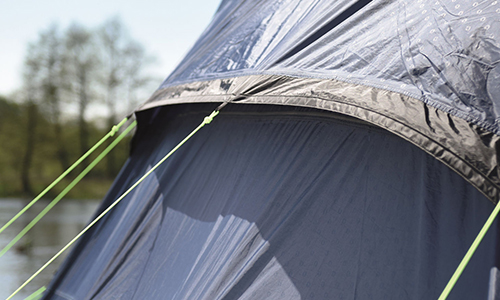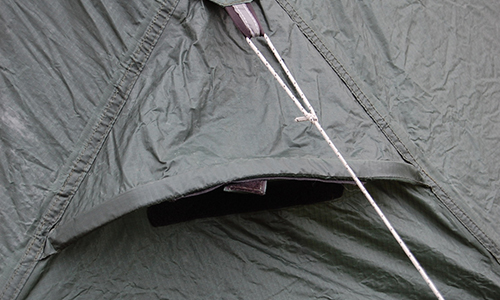Keep Your Camping Tent Dry with the Following Tips
Author

A keen runner, skier and nuts about cycling. Karl lives in Cumbria, where he loves encouraging his two children to follow in his outdoor lifestyle. Whilst out and about keeping active, Karl keeps a diary and shares it with Outdoor Look.
 Rainfall makes everything seem so fresh and beautiful. While trekking, I enjoy a slight drizzle as it rejuvenates my tired spirits. The greens get greener, the flower drip droplets creating a mesmerising view, and the nature simply seems to be in its finest form when the thunder strikes.
Rainfall makes everything seem so fresh and beautiful. While trekking, I enjoy a slight drizzle as it rejuvenates my tired spirits. The greens get greener, the flower drip droplets creating a mesmerising view, and the nature simply seems to be in its finest form when the thunder strikes.
However, when it comes to pitching a tent for nightly rest, the rain turns into my worst enemy. With dripping droplets inside my tent, my haven transforms into an unpleasant place. Condensation at night, is another major issue that I have faced on my camping trips that leads to wetness inside the tent. After struggling for a year or so with rain and nightly condensation, I decided to solve my problem by learning about preventive measures that could stop precipitation. All my research paid rich dividends, and I was able to overcome the issue. Here, I would like to share with you my experience, so you do not suffer from the problems created by a wet tent.
There are three strategies you can employ for creating a dry haven in the wild.
Camp Near Trees
The air under the tree is always warmer than the air found in the open fields. Find a tree that has a large spawn, so that air cold air is restricted to a bare minimum. The impact of rain will be minimized and condensation that happens at night will take place in the foliage of the tree instead of your tent.
Reduce Additional Moisture Sources Inside Your Tent
- Apart from external elements, there are three major reasons for moisture in a tent:Humid air inside the tent
- Moisture inside the tent by each breath you take at night
- Wet items inside the tent that create moisture
When you are inside a tent, you have no other option but to breathe in whatever air is present inside the tent. You cannot control what is outside, but you can always tweak the internal elements as per your requirements. The internal elements mentioned above are within your control and you can adjust them or eliminate them, and minimize the moisture level. Always dry things before getting inside the tent, so that the moisture content is at its lowest.
Ventilate Early, Often and Fully
 Ventilating the inside of the tent is a great way to remove moisture. Below are a few steps that you can follow for replacing the interior air with the dry air:
Ventilating the inside of the tent is a great way to remove moisture. Below are a few steps that you can follow for replacing the interior air with the dry air:
- If there is a gentle breeze outside, pitch your tent so the door is facing into it.
- It’s always better to open all rainfly doors and roll up sections. You should only deploy them if the rain starts to fall.
- Stake the tent out tightly and tension the fly for maximising the airspace between it and the wall of the tent.
- Make a habit of opening all rainfly vents, especially opposing ones for cross ventilation.
- Make sure that you open all inner tent windows.
By following the above-mentioned strategies, I could minimise the moisture level considerably. Now my nocturnal experiences have improved a great deal and I am able to sleep in peace. I hope you follow my plan and gain the same sense of satisfaction while resting. As rest recharges your batteries on a gruelling hike, you should never compromise on your comfort and keep the moisture away.
Author

A keen runner, skier and nuts about cycling. Karl lives in Cumbria, where he loves encouraging his two children to follow in his outdoor lifestyle. Whilst out and about keeping active, Karl keeps a diary and shares it with Outdoor Look.
Categories
- Sport (28)
- Product Reviews (3)
- Team Outdoor Look (7)
- Mike Wild (2)
- Mike Payton (2)
- Suse Hammond-Pears (3)
- Snowboarding (12)
- Latest Offers (105)
- Shop Talk (1)
- Competitions (7)
- Walking (413)
- Lifestyle Fashion (8)
- Travel (86)
- Kit Guides (176)
- Workwear Clothing (6)
- Safety Workwear (4)
- Health/Fitness (289)
- Skiing (91)
- Great Outdoors (1316)
- Cycling (92)
- January 2025
- December 2024
- November 2024
- October 2024
- September 2024
- August 2024
- July 2024
- June 2024
- May 2024
- April 2024
- March 2024
- February 2024
- January 2024
- December 2023
- November 2023
- October 2023
- September 2023
- August 2023
- July 2023
- June 2023
- May 2023
- April 2023
- March 2023
- February 2023
- January 2023
- December 2022
- November 2022
- October 2022
- September 2022
- August 2022
- July 2022
- June 2022
- May 2022
- April 2022
- March 2022
- February 2022
- January 2022
- December 2021
- November 2021
- October 2021
- September 2021
- August 2021
- July 2021
- June 2021
- May 2021
- April 2021
- March 2021
- February 2021
- January 2021
- December 2020
- November 2020
- October 2020
- September 2020
- August 2020
- July 2020
- June 2020
- May 2020
- April 2020
- March 2020
- February 2020
- January 2020
- December 2019
- November 2019
- October 2019
- September 2019
- August 2019
- July 2019
- June 2019
- May 2019
- April 2019
- March 2019
- February 2019
- January 2019
- December 2018
- November 2018
- October 2018
- September 2018
- August 2018
- July 2018
- June 2018
- May 2018
- April 2018
- March 2018
- February 2018
- January 2018
- December 2017
- November 2017
- October 2017
- September 2017
- August 2017
- July 2017
- June 2017
- May 2017
- April 2017
- March 2017
- February 2017
- January 2017
- December 2016
- November 2016
- October 2016
- September 2016
- August 2016
- July 2016
- June 2016
- May 2016
- April 2016
- March 2016
- February 2016
- January 2016
- December 2015
- November 2015
- October 2015
- September 2015
- August 2015
- July 2015
- June 2015
- May 2015
- April 2015
- March 2015
- February 2015
- January 2015
- December 2014
- November 2014
- October 2014
- September 2014
- August 2014
- July 2014
- June 2014
- May 2014
- April 2014
- March 2014
- February 2014
- January 2014
- December 2013
- November 2013
- October 2013
- September 2013
- August 2013
- July 2013
- June 2013
- May 2013
- April 2013
- March 2013
- February 2013
- January 2013
- December 2012
- November 2012
- October 2012
- September 2012
- August 2012
- July 2012
- June 2012
- May 2012
- April 2012
- March 2012
- February 2012
- January 2012
- December 2011
- November 2011
- October 2011
- September 2011
- August 2011
- May 2010
- April 2010
- March 2010
- February 2010
- January 2010
- November 2009
- October 2009
- September 2009
Submit a Comment